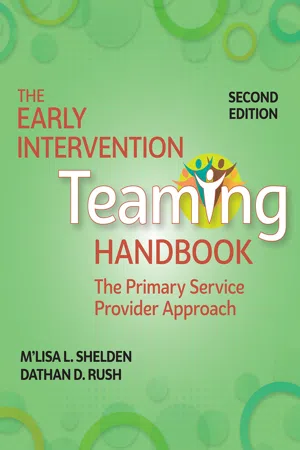![]()
CHAPTER 1
Introduction to a Primary Service Provider Approach to Teaming
The audience was already a bit unsettled: 200 early intervention providers in tiered stadium-type seating ready to fight for their professional identities and ethics. It was 1990, and the group was gathered to learn more about primary service provider (PSP) teaming, a transdisciplinary model of service delivery in early intervention set to be implemented statewide. Participants were members of existing teams that included psychologists, social workers, child development specialists, speech-language pathologists (SLPs), and newly added members from occupational therapy and physical therapy. Many resented that the state was trying to cram another program with more regulations and requirements down their throats. Moreover, the state was attempting to dictate how they were to provide their services. This was crossing a line, and providers were not willing to sit by passively and be told how to practice their chosen professions.
Sandwiched in the crowd was a speech-language pathology supervisor tapped to work in the new Part H early intervention program. He seated himself with a group of SLP supervisors and other members of his team. They had been anticipating this event for weeks and were not supportive of this misguided new model. The implications of transdisciplinary teaming were unsettling: “If I’d wanted to be a physical therapist, I would have gone to physical therapy school.” “How am I expected to teach someone everything I learned about communication intervention in graduate school?” “I don’t want to be held liable if someone does something wrong and a child is injured.” “Well, I’m an SLP, I’m not about to do stretching exercises with a child.” “I’m just not going to do it!”
Like a gladiator thrown to the lions in ancient Rome, the program director entered the room. She approached the microphone and made a few brief remarks about the federal regulations in IDEA Part H, requirements for teaming, and best practice in transdisciplinary service delivery. This, she told the crowd, would be the first of several meetings to help providers learn how to use the PSP model.
Silence.
The director then introduced the speaker—a physical therapy faculty member from a large state-funded university. Wearing her signature mismatched earrings and red Converse high-tops, she approached the podium seemingly unaware of the intense feelings surrounding her. She went through her presentation, trying to make her case for a transdisciplinary model of service delivery in early intervention. As she reviewed the other models of service delivery, some providers recognized that they had been using a variation of multidisciplinary service delivery already—they met weekly to report about children on their caseload but typically did not receive feedback, information, or support from other team members. Outside of the team meeting, each service provider worked independently on separate treatment plans.
After the morning break, the audience members could contain their angst no longer. In fact, most were unable or unwilling to listen to what the speaker had said prior to this time because they had such intense preconceived notions about what she was going to say that conflicted with their personal values and beliefs about how they should work with young children. The first words out of the speaker’s mouth once everyone was settled back in their seats were, “Does anyone have any questions about what I have shared so far?” Hands shot up across the auditorium. Some people, unable to precede their words with a raised hand, yelled out their questions and concerns.
“What research do you have that says this is what we should be doing?”
“Why is this so much better than what we already do?”
“If a child has severe disabilities, then don’t more therapists naturally have to be involved?”
“Maybe this can work for children with mild disabilities, but I can’t imagine how it would work for children with multiple and severe disabilities or children with autism.”
“Yeah, maybe if the child only has speech issues and the speech-language pathologist is the primary provider, then it might work.”
“What are the liability issues of having a speech-language pathologist do occupational therapy?”
“What if a parent wants all of the therapists involved, wouldn’t we be violating family-centered practices if we tell them they have to pick just one?”
“This sounds unethical and against my practice act. What do the professional organizations have to say about all of this?”
“One specific service delivery model isn’t the best option for every family. Why can’t teams decide which service delivery model to use? After all, we are professionals!”
“This sounds like watered-down service to me. Is the state trying to save money or something?”
“Yeah, it makes me think you believe that just anybody can come in and provide services to the children. Are you trying to minimize the need for specialized therapists?”
Many of the questions were followed by applause from the audience. One by one, the speaker addressed each of the questions and concerns as she continued through the presentation and showed a videotape of assessment and intervention using a transdisciplinary model.
At the end of the day, one of the SLPs turned to her supervisor and asked, “What do you think about all of this?”
“I’m not sure. She made some interesting points. I’ve been concerned about all of the people coming and going from the families’ homes. It seems like such a disruption in their lives. I didn’t hear her say that the physical therapist would be doing speech and the speech-language pathologist would be doing occupational therapy. I heard that we need to work more closely together on the goals for the child and family, and we need to change what we do when we are with the family in their home or community. From what she said, it sounds like other team members can go with the primary person if there are questions. I mean, it wouldn’t make sense for them to need to go every time, but . . .”
“I hear what you’re saying, but I think it’s going to be a huge change for all of us.”
“I don’t disagree with that. I think I need to read the handouts more carefully and look up some of these reference articles that she gave us. You know, people can get research to back up just about any position they want to promote. I need to read some of this for myself. If I need to rethink how I have been practicing or if I can even improve my practices a little bit to have better results for children and families, then I’m willing to do that. I don’t quite understand why the federal government, the state, and some of the researchers in these articles would be promoting this if it was such a bad thing to do.”
“I don’t know either.”
“Maybe they’re paying her big bucks to do this.”
They looked at each other simultaneously and said, “Not!”
“With the hostility in this room, I’d say she earned whatever she got.”
“I’d say so.”
The speech-language services supervisor struggled with the questions and what the physical therapist (PT) had shared during the presentation. He searched to find any available written information about the practices in order to help him better understand the rationale and research. If this type of teaming model really was the way in which early intervention should be provided to infants, toddlers, and their families, then he wished for a comprehensive resource that would explain how to operationalize these practices, beginning with a synthesis of the available research followed by how to prepare a program for this type of team-based approach to procedures for how to operationalize these practices in real early intervention programs.
The speech-language services supervisor’s journey to understanding a PSP approach to teaming in early intervention began in 1990. He served on a team with the PT who provided the initial statewide training on a primary provider approach. Together, they have continued to work together to better understand how to use evidence-based practices in early childhood intervention to support the growth and development of young children and families via a PSP (e.g., primary provider, primary coach, team lead, lead provider, team liaison, key worker) as well as support other early intervention team members in using these practices. So far, their journey has taken them from the homes of families with whom they have individually worked to most every state in the country and abroad as they continue to define, refine, and examine the effectiveness of a primary provider teaming model. Many viewpoints, perceptions, and misperceptions exist about using a PSP in early intervention, as experienced by the SLP in this partnership.
The purpose of this text is to provide a common definition, characteristics of the practice, and implementation strategies for using a PSP approach to teaming within the context of evidence-based practices in early childhood intervention. This information is based on research in how people learn, early childhood intervention, family-centered helpgiving, and team-based supports as operationalized through the authors’ more than 30 years of experience in the fields of physical therapy, speech-language pathology, early childhood special education (ECSE), and early intervention as well as the experiences of early intervention teams using these practices across the United States and beyond.
A BRIEF OVERVIEW OF COMMON TEAMING MODELS
Using teams comprised of individuals with a variety of expertise and knowledge in the field of early childhood intervention has been a consistent component of education legislation (Individuals with Disabilities Education Act Amendments [IDEA] of 1997 [PL 105-17]), recommended practice documents (Division for Early Childhood, 2014), and theoretical and research literature over the last 40 years (Antoniadis & Videlock, 1991; Briggs, 1997; Dunst et al., 2007; King et al., 2009; Nash, 1990; Nash, 2008; Sloper et al., 2006; Woodruff & McGonigel, 1988). Bell (2007) stated that a survey of U.S. organizations indicated that more than 48% use teams of some sort. Acknowledging the large amount of work contributed by teams in the workplace is commonplace in business and industry (West, 2012) as well as in education (Malone & Gallagher, 2010; Silverman et al., 2010) and health care contexts (Nandiwada & Dang-Vu, 2010; Weller et al., 2014).
Historically, several different teaming models for providing early childhood services have been suggested in the literature. The multidisciplinary, interdisciplinary, and transdisciplinary team approaches are three models of team interaction that have been readily discussed. The approaches differ based on the level of team interaction, parental involvement, the assessment process, and intervention methods (Fewell, 1983; Haynes, 1976; Kingsley & Mailloux, 2013; Peterson, 1987; Woodruff & McGonigel, 1988).
A multidisciplinary approach to teaming was initially defined as a group of professionals who work independently and interact minimally with each other (McGonigel et al., 1994; Woodruff & McGonigel, 1988). Each member of the team performed a separate evaluation and wrote an individual report, including discipline-specific goals. Each practitioner then performed intervention at separate times and focused on the remediation of the weaknesses noted during the evaluation (McGonigel et al., 1994; Rush & Shelden, 1996). When a multidisciplinary team functioned in this manner, team members viewed the child based on identified deficits from their own discipline’s perspective and children received discipline-specific interventions that may have resulted in overlaps and gaps in services (Giangreco, 1986; Orelove & Sobsey, 1996).
Interdisciplinary teams traditionally had more interaction among the team members on an ongoing basis. Each team member continued to perform a discipline-specific evaluation and write discipline-specific goals. The team met to discuss the results of each evaluation and develop an intervention plan (McGonigel et al., 1994; Woodruff & McGonigel, 1988). Team members provided intervention services at different times and discussion among team members occurred primarily at team meetings (Fewell, 1983; Peterson, 1987; Rush & Shelden, 1996). The primary purpose of team meetings in an interdisciplinary approach was for each discipline to report on child status.
Several authors described tran...

